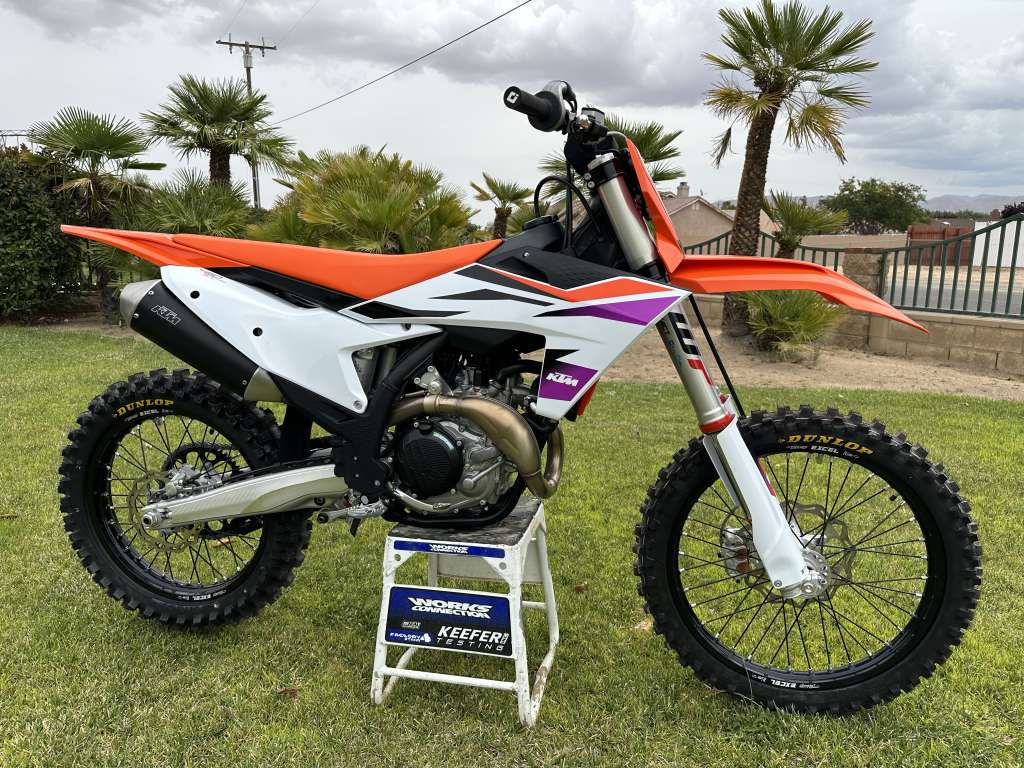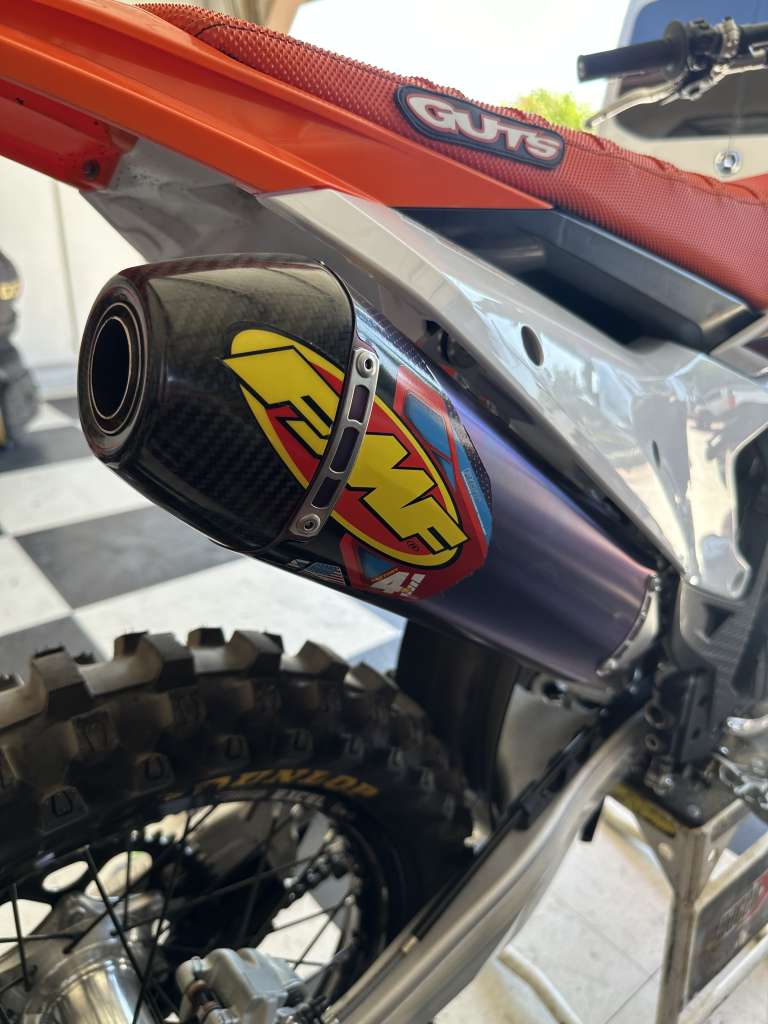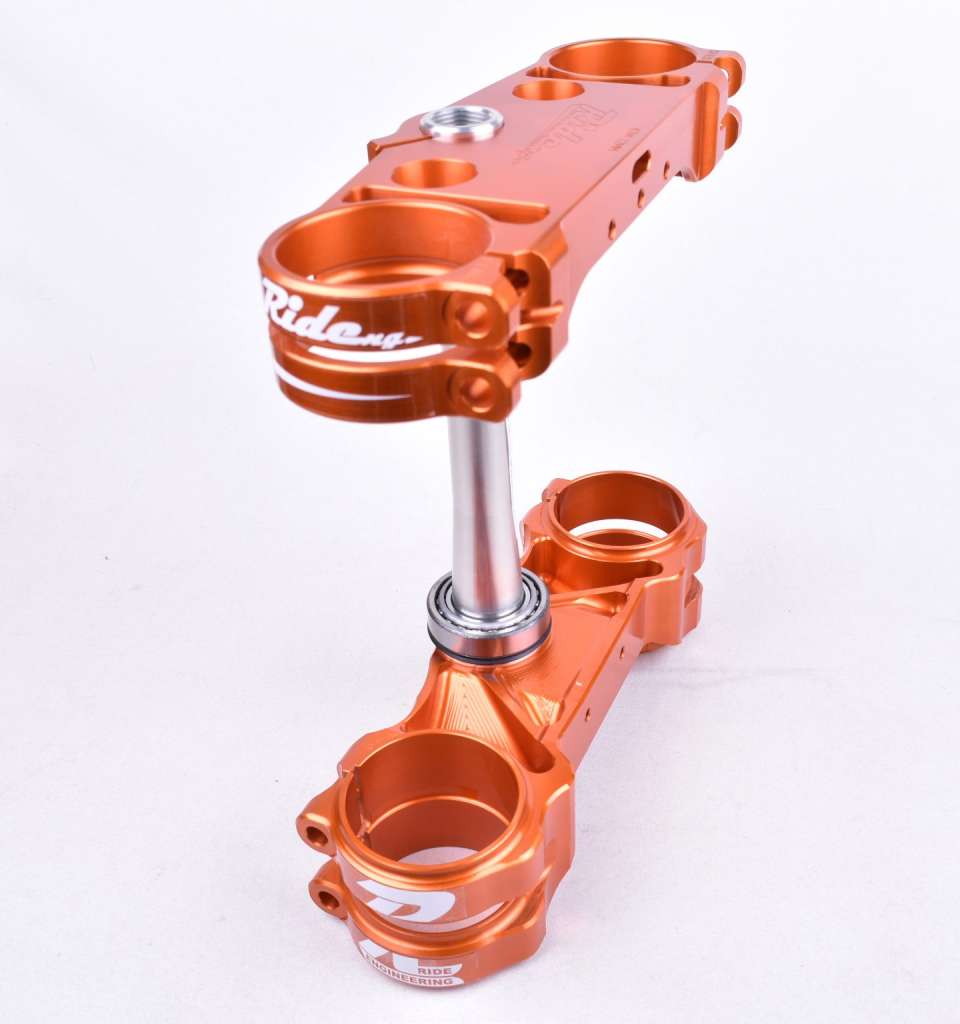Share This Article
The 2024 KTM SX-F lineup is the same as the 2023 version but that didn’t stop us from going through our settings again to see what was good and what could use some improvement. Specifically, the KTM 450 SX-F is still a stiffer nature feel and will take some time to break in. Even when broken in, the KTM 450 SX-F will still feel a little firm on the edge of its tires. Torque specs will help as well as going to a 23.5/24mm offset. This helps the KTM with compliancy as well as give the rider a better feel. Here are some baseline settings as well as som tips/tricks for your new orange ride. With these settings along with the mods down below, this orange machine is a weapon that takes less energy to go fast on.

Suspension: Try these settings if you’re anywhere near the 175-200 pound mark. This setting, along with the other chassis mods here (after at least an 8 hour break in period) should help the KTM feel less harsh and settle more.
Fork:
Height: 5mm
Air Pressure: 10.9 bar
C: 14 out
R: 15 out
Shock:
Sag: 103mm
LSC: 12 out
HSC: 1.25 out
R: 15 out
Torque Specs: Even though some engineers say that torque spec doesn’t really matter in the grand scheme of “feel” on the bike, my body says different. The KTM chassis feels rigid from the swingarm pivot bolt back as I get a lot of deflection (side to side) movement on braking bumps as well as acceleration bumps. Lowering the torque spec to 95 Nm (on swingarm pivot) helps settle the rear end slightly as well as helps the rear of the bike keep straight during off throttle situations. This will not give you added comfort, but will help settle the chassis with side to side movement (mostly on-throttle type situations).

Aftermarket Muffler System: I have NOT tried all of the mufflers available for the KTM 450 SX-F but if you can get your hands on a FMF system for the 2023 KTM 450 SX-F, you will be getting more mid range and top end pull without sacrificing too much low end. In fact, you will be getting slightly less rpm response but a better torque feel out of corners. I leave the insert inside the muffler on the 450 unlike the 350 where I take it out.
Handlebars/bends/grips: Going to a Pro Taper Husqvarna Stock EVO bend (cut to 800-803mm) will help with vibration as well as give the rider more comfort through his hands. Another option for riders is going with the FASST Co. FLEXX 12* Moto handlebar that offers the most flex for the rider, but this bar does take sometime to get used to visually.
Gearing: I am still running a 13/51 set up and so far this is working out.
Chain Slack Measurement: 65mm-70mm may look like a lot of chain slack when your bike is on the stand but KTM assures me/and you that this is the proper amount of slack. This spec allows your suspension to move freely and not bind when under load. This also will help keep from your chain snapping because of a too tight tension spec.

Triple Clamps: Because the 2024 KTM chassis is a less stable on straight line (hard pack choppy conditions) than the 2022 a set of 23.5mm offset clamps really helps calm the orange bike chassis as well as gives the rider more front end feel/positivity. Going into this 23.5mm offset test I thought I may feel an even slower cornering KTM, but this actually helps the KTM turn into ruts better with more front end feel/traction. Ride Engineering is making 23.5mm split clamps for this model and to me this is a noticeable improvement with this 2024 chassis. This offset calms the bike off throttle (de-cel bumps) and allows the rider to set up better for the corners without having the chassis deflect off of braking bumps. To me, it made the new chassis feel less firm on braking bumps. Now you don’t have to go to a Ride Eng. clamp to get the benefit mentioned above, if you prefer another split clamp design that is fine, but I have not tried any others as of yet so I don’t know other brands flex characteristics.
ECU: Since the newer KTMs have locked stock ECUs, remapping them is NOT an option. I have been going back and forth between the AIM Taipan and Vortex ECUs and although both are much better than the stock mapping, the Vortex is easier to get and more tuners know how to tune the Vortex than the AIM. With KTMs new transmission ratio, I have found second gear to be not as long as I wanted, so instead of changing my gearing (leaving the stock 13/51 ratio), I went for a Vortex ECU mapped by XPR Racing and this gave me more freedom to either ride in second through corners or lug it more in third. The stock 450 SX-F wants to be in second gear in corners so adding a little “meat” to the power helps with the XPR tuned Vortex. The stock ECU almost feels slightly disconnected at lower rpms, but with the Vortex I get a more linear low end feel with much more mid-top end pulling power. Accelerating out of corners is an eye opener as the KTM gets from point A to point B in a hurry with more rear wheel traction/connection. The Vortex ECU also helps with rear wheel traction which allows you to get on the throttle harder/earlier.
WP 6500 Spring Conversion: I have been riding with the stock AER fork and stock shock as well as the WP 6500 inserts and Pro Component shock. The new WP XACT Pro 6500 Cartridge kit is a straightforward closed-cartridge (CC) coil-spring conversion system. It drops right into your current WP XACT 48mm AER air fork with no additional modification or machining. This is not the same as the WP’s XACT Pro 7548 complete fork assembly, or most notably knows as, the Cone Valve fork. You can purchase the 6500 kit with preset springs/valving for around $1400.00 which is considerably less than the CV fork system. I have been using REP/AEO settings in the 6500 fork with great success. I have however put some test time in with Mark (owner of REP) at the track to get some settings that create more comfort with the 23 chassis. The stock 6500 drop ins that come straight from WP will give you more front end feel than the AER fork as well as more lean angle traction on initial lean (area 1 of corners). The downside of the stock setting that the 6500’s come with from WP is damping feeling near end stroke. You can ask for a “comfort” setting or a “performance” setting when ordering the 6500 kit from WP, but when equipped with the comfort setting, the fork rides lower in the stroke and can cause some mid stroke harshness. When running the “performance” setting, the fork can be a little harsh on edge of tire so I wanted something in the middle or in rider’s terms “the best of both worlds”!
Tires: Take off the Dunlop MX33 tires and replace them with the newer MX34. Also running a 110 rear tire is recommended at most tracks rather than a 120. Only time I will run a 120 rear tire is if I go to a MX14. The MX14 has a slightly narrower profile on the MX14 so a 120 is sufficient in that regard.
